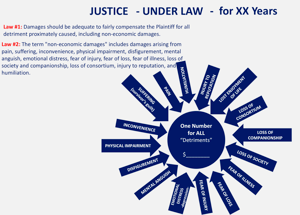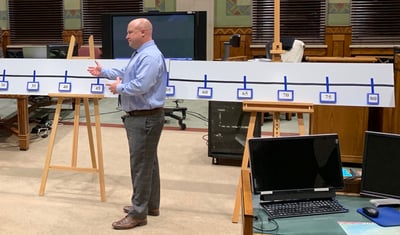
First Court has helped our clients to win some of the biggest cases in recent judicial history.
Four years ago, our research assisted the defendants in the Aurora Theatre shooting civil case in winning a defense verdict.
Recently, we helped the plaintiff victims of a drunk driver win a record verdict of more than $1 billion to compensate for the death of two young women and catastrophic injuries to a third.
We have compiled and shared the key lessons from these landmark decisions for advocates on either side of a case with big verdict potential:
Non-economic damages drive up value
Economic damages tend to involve fewer variables and drive less emotion with jurors. This is where defendants should focus - get into details, tie value to discrete figures, and set an anchor for damage amounts. Conversely, plaintiffs in trial must minimize the time and attention focused on liability and economic losses, and direct the juror’s minds towards non-economic damages. Plaintiffs must position the economic damages as a given, and consistently tell jurors that the intangible, non-economic damages are the most important loss an injured person faces. This is where big value can be unlocked.
Connect facts and the law
With minor variations, the law in every state requires that damages fairly compensate plaintiffs for all damages, economic and non-economic. The definition of compensable non-economic damages tends to include a litany of items ranging from pain and suffering to humiliation. Detailing how an injury has caused damages in each of those distinct categories is a powerful way for plaintiffs to win big, non-economic damages. Associating injuries with the letter of the law, and arriving at bigger amounts by combining many smaller ones makes large awards much more reasonable in juror’s minds. In our $1 billion case, the law said that the plaintiff should be compensated for a wide range of non-economic damages, and the facts were that the deaths and devastating injuries in this case had caused grievous losses in many ways.
Big emotions = Big damages
If there is one common thread from our three decades of jury research experience, it’s that emotions are the key to unlocking big awards. Even a slam-dunk liability case with big specials will not lead to a big verdict - unless jurors are angry at the defendant, or sympathetic to the plaintiff, or both. In the DUI case, we had both. In the Aurora shooting, the defense successfully mitigated both, by directing the juror’s anger to its correct source - the shooter - instead of the theatre.
Be Consistent 
Finally, success in a big case is predicated on consistency. Our billion-dollar jurors trusted the plaintiff attorney. Why? Because every single thing he said and did was credible and consistent. Many plaintiffs make the mistake of spending lots of trial time on liability and medicals and lost wages... and then tell a jury in the last 60 seconds of closing that the most important thing in the case is non-economic injuries. This is a mistake. Spending time on an issue makes it important. So you must spend time - from voir dire to closing - on what you say is most important. For plaintiffs, that's typically non-economic damages. In this case, plaintiff attorney Jeff Weikum used a 20-foot long timeline to illustrate how the victim's damages would be multiplied over the decades of life they lost, and consistently set his arguments in that frame throughout the trial.
These are the nuts and bolts, but applying them in the heat of a trial is tough to execute well. To guarantee the best outcome, advocates MUST prepare.
First Court has developed a proven approach that allows our clients to prepare for battle, and consistently win their biggest cases:
-
Early objective feedback
Learn exactly what arguments resonate with the people who will be on your jury. Play with different themes and arguments early on using flexible online focus groups, and learn the characteristics of your best and worst jurors. Recognize that what you initially think is the best approach, may not actually click with regular people in your venue. Find that out early, and invest your trial prep building around a winning theme. -
Dress-rehearsal
Polish your presentation and delivery with a pre-trial private jury trial. Rehearse your voir dire with a group of laypeople from the venue who look, think, and respond exactly how your public jurors will. Feel the heat of presenting to a live panel of laypeople from your venue, before your public trial, and go into the courtroom knowing that your preparation has been exceptional.
-
Win in Voir Dire
Use powerful software to compile publicly available information and learn everything possible about your prospective jurors in advance. Then, position the case in your preferred frame from the very start. Make the best use of your limited questions and strikes, and go into openings with a jury you know a great deal about, primed to see the case through your lens.
This approach requires hard work, but is incredibly rewarding when the verdict comes in. With advances in technology, it’s becoming more and more cost-effective to leverage these powerful tools in a wider range of case values. The biggest verdicts grab the headlines, but the same methods can be scaled to fit almost any case going to trial.
Big verdicts are becoming more common, but are never an accident. Take control of jury trial outcomes using First Court’s proven model to win trials big and small, and be on the winning side of your next big case.
Ready to learn more? Schedule a time to talk.
Tags:
Jurors, Voir Dire, Advocacy, Jury Research, Emotion, Law, jury trial, voir dire rehearsal, jury selection, North Dakota
Nov 8, 2019 3:55:32 PM



Comments